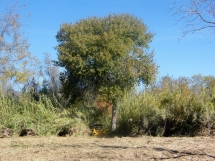Our lab and UCSB's Cheadle Center for Biodiversity and Ecological Restoration are working with regional partners to restore over 150 acres of riparian habitat in the Santa Clara river to benefit wildlife and natural resources. The project area is located in Santa Paula and Fillmore (Ventura County) between the confluences of Sespe and Santa Paula Creeks. The riparian corridor in this reach historically known as East Grove is up to ¾ mile wide and supports perennial flows, artesian springs, riparian forests, marshes, ponds, and other diverse wetland habitats. Human encroachment into and modification of the flood plain and riparian habitat have altered the ecosystem properties of the watershed, leading to riparian and aquatic habitat loss and degradation (Stillwater Sciences 2008). Manipulation of water resources has caused severe impairment of water quality and the natural hydrologic function of the river and may be responsible for the decline of dependent species in the watershed. Monitoring activities over the past 20 years have shown that many of the species listed by Schwartzberg and Moore (1995) as historically present are now either locally extinct or critically endangered, including southern steelhead trout, least Bell’s Vireo, and red legged frogs (Court et al. 2000)
The continued introduction and impacts of non-native, invasive species pose a significant threat to biodiversity and natural resources in the watershed and have become a key issue in watershed planning and management. Arundo (Arundo donax; giant reed), a large grass introduced from Eurasia, is the primary plant species of concern in the watershed where it outcompetes native species, reduces habitat value, and alters fire and flood regimes (Lambert et al. 2010). Other invasive plant species impacting the project area include tamarisk (Tamarix spp.), castor bean (Ricinus communis), perennial pepperweed (Lepidium latifolium), and exotic annual forbs. Invasive African clawed (Xenopus laevis) and bullfrogs (Rana catesbeiana) are abundant in standing water habitats in the project area where they prey on native frog and fish species, leading to declines in several sensitive species (Peek 2006). Research by UCSB scientists aims to understand the ecological impacts of invasive species on the river system and develop strategies for reducing these impacts while promoting the recovery of sensitive and endangered native species.
Our program focuses on:
- Research, education and outreach
- Invasive species control
- Restoration and monitoring
- Conservation of sensitive species and habitats
Project partners:
- Friends of the Santa Clara River
- United States Department of Fish and Wildlife
- California Department of Fish ahd Wildlife
- CalTrout
- Western Foundation for Vertebrate Zoology
- Hansen Agricultural Center - University of California, Division of Agriculture and Natural Resources
- CSU Channel Islands
- Sierra Club Ventura
- Fillmore United School District

